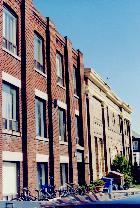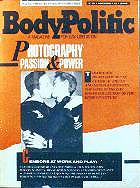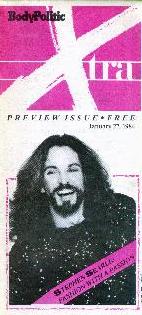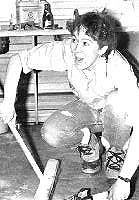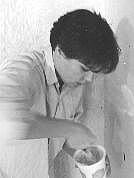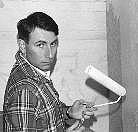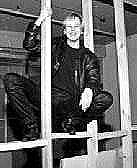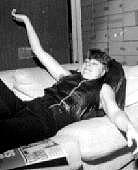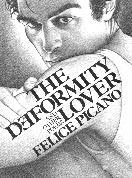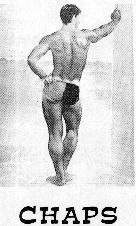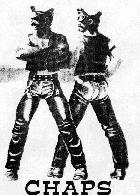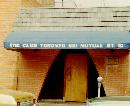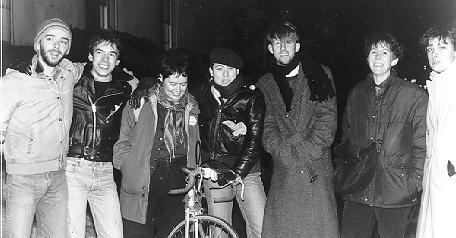|
Promiscuous |
|
Queen farther West
New digs at 54 Wolseley:
|
At Wolesley we'd see new neighbours, more new faces, & the birth of a new little paper -- that grew.
|
Porn again (Not a peep from the police)
You'll get a charge
|
|
A little something (e)xtra
Xtra, Jan 27, 1984:
|
|
Reno Beepers
Construction crew at 54:
|
1984
January through June
The Body Politic's days on Duncan were numbered: the landlord meant to sell the building. In time he did, the whole area going to upscale offices, bistros and nightclubs. The site where we'd seen so much history, two police raids part of it, would sit amidst streets signed "The Entertainment District." Our tenure ended in entertainment -- and in a final police raid.
We'd found a place at 54 Wolseley Street, near Bathurst and Queen. With TBP's January / February 1984 issue done in mid December, Beepers and Canadian Gay Archvists turned construction crew there, packers at Duncan, and movers in between. In the snow.
The move was hell. When it was over we deserved a party so we threw one ("Westward Homo! From 24 to 54 in '84") -- 24 now vacant and vast and, on Saturday night, January 28, turned into a giant disco.
Lights that more often flashed over GCDC dances were hung from the ceiling of what had been the Canadian Gay Archives; Gordie Crone set up his DJ booth where once Gerald, Chris and Ed had slogged over the news. (Gordie was a pro -- and a flirt: he worked in a stationery store where I got stuff for the paper; he'd sidle up while he did the bill, offering his crotch for a squeeze. I'd later give him more than a feel.)
People danced long into the night -- in fact, until precisely 3:15 am. That's when the police arrived: our big BYOB bash was busted as a booze can.
Those two cops likely expected a booze can crew, not the defiant crowd they found; perhaps they didn't know the site's history. They called for back up, told everyone to leave. No one moved. Danny Cockerline got mouthy and was dragged down the stairs -- in a little blue dress with a very short skirt. He'd spend the night that way in a cell at 52 Division, charged with public intoxication.
Ed Jackson and Kevin Orr faced charges of "unlawfully keeping liquor for sale." No booze had been sold; they'd later be charged with "displaying liquor to public view." At trial in May, both charges would be dropped. But we had departed 24 Duncan, one might say, in the style to which we were accustomed.
We began at Wolseley in the same tradition. Or tried to. Tom Waugh's second piece on the pornography collections of the Kinsey Institute, this one on still photographs, had been laid out for months but we'd held off on it while still in court.
Its images were explicit; Clayton Ruby was sure we'd be charged for them. Kevin Orr's lawyer checked the layout and advised we give it a more academic look (it was a study, after all). We did.
It ran in the March 1984 issue, five pages complete with mutual masturbation circa 1890, World War II sailors kissing, cocks poking out of unbuttoned bells, three shots of fellatio from 1895 to 1945 and one of autofellatio -- a famous photo by Baron Wilhelm von Gloeden of a Sicilian boy sucking himself off. Tom's analysis of it all -- body positions, power relations, class, age, even gender based roles -- was, of course, excellent.
For the first time we had published a piece for which we expected to be charged. In fact some of us hoped to be, reviving that clear, clean sense of purpose that had faded once we were no longer battling the state in court. Chris Bearchell even suggested we send the March issue directly to the police -- as if they wouldn't find it on their own.
Not everyone was so eager. But we were ready. All records that might personally implicate anyone in the decision to publish the article were gathered together and removed from the office. (To this day they are still together, in their own box in the Canadian Lesbian and Gay Archives.) An alternate feature was ready to run if the printers balked; they did call, concerned, but printed the issue anyway.
It went on sale, stayed on for its usual run, replaced in due course by the April number -- all with not a peep from the police, then or later. We'd have to find our sense of purpose elsewhere.
We had new neighbours at Wolseley: Theatre Passe Muraille just around the corner; the Canadian Periodical Publishers Association (of which TBP had been a member since 1975, for a time Gerald on its board) just downstairs. Again, proximity would bring synergy.
We also had a new project, born of deliberations occupying much of 1983 on how we might reach a wider audience than The Body Politic could on its own. Initial plans had been grand, calling for a new publication of some substance. They had resulted -- for the moment -- in something more modest: a four page tabloid for a time folded to pocket size, published twice a month: Xtra.
It was intended almost literally as an "extra," coming out more often and getting into places TBP couldn't easily go: bar, baths, clubs and community venues that didn't usually sell papers but were glad to give one away. Xtra was free, entirely financed by advertising revenue, and clearly local in focus.
It was meant to embody the same politics as its parent, if in tastier, bite sized bits. Early on one bit was Bar Wars, a column by Paul Baker, opera queen collective member, writing as "Lotta Dish." (Sometimes half a dish too much, even for a bar rag.) Xtra's core was listings of places and events, much like the ones that first ran in Out in the City three years before. It would take over that role entirely in 1985, Out in the City gone from TBP's pages. In time Xtra would have an even bigger role to play, The Body Politic itself gone, too.
But for now, little Xtra growing by its side, The Beep plugged on, many new Beepers plugging away with it. In the summer of 1983 we had changed (yet again) the criteria for collective membership, adding 16 people to the eight already on board. Those 16 were not new, very much on board if not before on the collective. Among them: Terry Farley, Craig Patterson, Edna Barker, Danny Cockerline, David Chang, Kevin Orr, Gillian Rodgerson, and Sue Golding.
Many had considerable influence already through their work in editorial groups; most soon found no more influence in sitting through another few meetings a month and let their collective membership lapse -- if few their wider place in the life of paper.
There were now lots of women in The Body Politic's life. Lee Lyons, a photographer and girlfriend of Gillian Rodgerson, was around by early 1983, briefly on the collective a few months later.
This February Lee Waldorf, a law student and quite glamorous, joined the Canadian news group; she'd be a collectivist within a year. (Last I saw Lee, she was doing her doctorate in law.) Sonja Mills arrived around the same time, butch complement to Lee's fem, and a playwright. (She'd later be president of Buddies in Bad Times Theatre, a role first filled by Sue Golding.)
Jane Smith, also a playwright, would show up in May with Barbara Klemme, who worked in production. Barbara was quiet, even distant, but I liked her -- Eddie said because she looked like a boy. Later she would be a boy, Barbara becoming Peter.
But, as I had written to Jane Rule in late 1983, I was most attracted to someone already a boy.
- His name is Robert Mealy, a new volunteer (what else provides such light around here?). He's on leave of absence from Harvard, playing here until May with a baroque chamber group, Tafelmusik. He spent the last two all nighters of production here, became attached to Kevin Orr and has remained so since -- all of a week so far.
Kevin and I went to see him in a performance of The Messiah last Wednesday, and both sat almost embarrassingly transfixed by him, intense in his white tie and tails, stretching and dipping subtly with the music and with his violin. When we told him how beautifully he moved when he played, he was surprised, saying he wasn't aware of doing it. Accomplished, beautiful, affectionate, incredibly smart, politically sharp. Twenty years old.
I saw Michael Wade and his new lover Douglas Chambers last night and told them about all this, but also said that I should probably know better than to get involved with someone twenty years old. No reflection on him, I told Michael; he gave me a skeptical look.
[For a pic of Robert, Kevin, Lee Waldorf, Sue Golding, and some other bright lights of the day, see the bottom of this page.]
Robert and Kevin's relationship would last well beyond a week, going on sometimes here, more often long distance, Robert back in Cambridge or off on tour around the world. (He'd become concertmaster of the Boston Camerata and director of Harvard's undergraduate baroque orchestra; in 1998 I'd see him in Toronto on tour with a company from Cologne.)
Michael Wade had met Douglas Chambers at Buddy's in late 1982. I'd known him as a gay activist at the university, head of the Trinity College English department, and as a writer for the paper. He was 10 years my senior so had 20 years on Mikey.
I wondered at that: Michael had moved from my shadow into one likely much deeper. But there, too, he thrived in his own way, becoming a graduate student in Classics. That relationship, too, would last for years, the three of us friends through all of it.
- March 20, 1984, to Jane:
Tonight I'm going to watch videos at one of the bars, to make notes for a piece about how they get edited and by whom.
It's not a terribly big issue but I (and others I've talked to) get irritated at the bars showing senseless snippets of porn flicks, all context removed along with anything that might be construed as too explicit. There's something demeaning about being thrown a few disjointed scraps, maybe all we're allowed, maybe all they think we're worth.
A few of the bars have put videos to better use: The Albany shows tapes (with sound -- often missing elsewhere) of concerts by people like Diana Ross and Bette Midler; the bar patrons become part of the audience, have fun, applaud, sometimes dance. In contrast, the chopped up come ons available on the screens at Chaps tend to produce zombies.
All this, if I get it done, is for Xtra, a medium distributed in bars (among other places) and which should, I think, deal with the kinds of things most apparent in bars. It's all, after all, politics.
|
9 Isabella
Hot Tub to hot Chaps:
|
|
Polished gods
The likely original:
Its imitators:
|
|
Macho meanies
Local homo promo, 1983-84:
|
|
Alternative icons
Goddess:
Demigods:
Jimmy's wondrous falsetto belied his Scot stud puppy persona. He was sometimes in town, having friends here. I once saw him at a U of T Homo Hop. (I recovered.) |
|
Battle of the Baths (Not here)
Still there, soon more:
|
"The problem isn't where gay men have sex, it's how."
It was a distinction often lost in the face of a disease replete with nasty "lifestyle" connotations.
For late '90s thoughts on the Battle of the Baths -- still going on in San Francisco -- see "Learning History by Half- light", one of many good articles on Kirk Read's website
(www.temenos.net/kirkread).
I never did get that article done, but I did hang around quite a bit at Chaps, mostly to watch boys dance. It was at 9 Isabella, just off Yonge, and not that site's first attempt at a dance spot. Shortly before The Hot Tub Club was raided there in 1979, it advertised a disco "now open, live DJ from midnight, side entrance," probably on its second floor.
That went with the Hot Tub itself, closed by the end of that year. Club Isabella took the site, "new owners, new management" its first ad read in TBP. It was likely the Club Baths' crew, the ad graphics familiar. Its second notice admitted it was a bath; that ad was its last.
Soon the old management announced Stage One, a dance club due there May 1, 1980; best I know, it never arrived. Later (or maybe before) the facade had been dressed as a restaurant: beige stucco, heavy ochre frames around the door and windows, a canopy running out to the street.
It was in this guise that Chaps opened, October 6, 1983. The place was packed from its first night, a cruisy bar and small eatery on its first floor, upstairs a dance palace then the grandest in the city.
Its first ad gave these spaces distinct names: The Penthouse Disco; Club 9; Chaps Café. But no one noticed: it was just Chaps. Neither did many heed the image in that ad: two men planted in wide legged stance, one facing forward the other back, his head turned, both with big dark moustaches and in heavy leather: Muir caps, vests, armbands and, of course, chaps.
In life I doubt Chaps ever saw more than a few pairs of chaps, its crowd more preppy, even disco swish. Within a year the place gave up the butch graphic for a lovely if still hunky man, his back to the viewer and his hips in a nice cant, dressed only in a bathing suit exposing a juicy but modest curve of cheek.
Chaps kept the colour original on display. I never knew the artist for sure, possibly Jim Shannon, his work in the same style -- but I did know the style: the surface textured as if done in charcoal, the shifting tones creating a subtly polished god.
I had first seen the look on the cover of Felice Picano's 1978 poetry collection, The Deformity Lover, the god there giving one an alluring stare. Reviewer Ian Young named the artist, George Stavrinos, and called his drawing "a knockout: it should seduce some readers who don't usually bother with poetry."
Stavrinos had also illustrated a 1978 guide, Gay Source, filling it with images that seduced many. Certainly many gay businesses: they soon filled their promo with men in the style of Stavrinos. If ads in TBP are an accurate sample, gay resorts and travel agents were among the first to adopt the look.
Soon we'd see bars and clubs adopt the look in their ads: almost always drawings, not photos, showing gay men how they looked. Or should look. Or at least want that man across the bar to look. Not everyone found it alluring.
- "According to the dictionary of our advertising, what is a gay man? Well, he's between the ages of 21 and 35. He's at least six feet tall and must spend a considerable amount of time in a gymnasium developing a spectacular, muscular torso, which is usually hairless."
"He has a moustache and sometimes a beard. He frowns a lot and hardly ever smiles. He attempts to exude sexuality by giving the impression of sexual unavailability. He is affluent -- how else could he afford all that leather? But he also wishes to identify with the working class, as evidenced by the jeans, T shirt and various 'rough and tumble' accessories. He is also, invariably, white.
"The predominance of macho imagery in gay advertising narrows the definition of what is or is not 'gay.' Sure, any cocksucker can be a homosexual, but not anybody can be 'gay' according to the light we cast upon ourselves."
That was David Vereschagin, in TBP's first issue of 1984. He'd been on the scene since the summer of '83, working in production and in time designing articles and covers on his own. His style was more quirky and interesting than mine and mostly I liked it; mine he called "boring." As I told Jane in that same letter in December 1983:
- People like Danny [Cockerline] and David here have, in a way, set themselves up as the bright young things being suppressed by the older folks, the old movement hacks who've become the new, clone identified establishment, impatient with New Wave cultural radicalism and threatened by its sexual ambiguity.
Danny has left the collective over disagreements about advertising, citing not only our lack of sufficient commitment to socialist ideals, but his sense that we make fun of the way he dresses. I for one like his pink pants and eye makeup, but would like them a lot better if they weren't meant, as they are, to be a lightning rod for nasty reactions.
In his article David checked a mirror and described his own attire: wire rim glasses; a loose purple shirt; turquoise pants; canary yellow sneakers. He said he liked to smile and laugh. "According to the rules of the cult of masculinity," he wrote, "not only am I not acceptably gay, I am not even sexually attractive. I know who made those rules. What I want to know is: why are we even playing this game?"
Those rules were being made -- by gay bars, not just in ads but at their doors. In June Chaps began barring people who looked too New Wave. Boots announced that women's clothes were for women only; a long time patron once voted "Mr Boots" got turfed for showing up in drag.
Working class dykes were turned away from The 101, a new dance club on Jarvis. Gay Asians of Toronto leafletted Chaps for discriminating by race; others picketted the place with signs that read "Punks are people, too."
Danny Cockerline wrote about all this near the end of the year. His "Out of the closet & out in the cold" cast such restrictions as a form of queerbashing. At one bar he got: "Guys aren't supposed to wear makeup, only girls are." "As I was led from the bar," he wrote, "I thought of how many times I'd been told, 'guys aren't supposed to suck cock.'"
In time all but the most serious leather bars would relent, adapting to new styles as they'd always had too. Drag queens once turned away would later be avidly sought, their shows a big attraction, especially at Chaps.
The Beep would also adapt, making space for fresher ways of seeing the world. And some fresher faces, too.
Andrew Zealley, who'd been on the cover of TBP in 1981 as a member of TBA, had moved inside to cover music for Out in the City (as he has since for Xtra). Alan McGinty did, too, his entrée a summer job at the city archives, James Fraser his boss, Danny Cockerline and Victor Bardawill fellow workers.
Alan had a sharp nose (a lanky redhead's freckled one) for pop trends -- and their passing, taking on David Bowie (in yet another incarnation) and warning that Frankie Goes to Hollywood were going the way of Duran Duran. (Frankie's big hit was "Relax -- When You Want to Come." Once in fitting circumstances, if outdoors, I got to tell Alan to "relax." He laughed. Then he did.)
David Vereschagin spent the a night watching music videos on CityTV -- the Thompson Twins, Talking Heads, Boy George, Cyndi Lauper -- and wrote about it, his piece in the September issue called "Shot by an electron gun."
In the issue before we'd run a big photo of Annie Lennox -- taken by Sonja Mills. (Sonja recovered.) In the issue where David glowed to the cathode ray, Sonja basked in the light of Toronto's Pride Day -- the fourth since 1981 but the first held at Church and Wellesley, now visibly gay downtown, the Second Cup's soon famous gab & gawk spot, The Steps, opened that April. Her piece, "Sonja just wants to have fun" (as Cyndi Lauper's girls did), had as a lead: "What do we want? Lesbians in trees! When do we want them? Now!"
"As the anniversary of the 1969 Stonewall riots," Sonja wrote of Pride Day, "it commemorates resistance to a kind of oppression that seems a little remote to me. In 1969, I was 7 years old."
For the first time since the late 1970s, people around the paper felt a generational divide, in style certainly but also in perceptions of the very work we were there to do.
Older hands came to be called, and call ourselves, "dinosaurs"; the new kids dubbed "mammals." We all know how evolution turned out, even if lumbering dinos did occasionally tromp on a few furry creatures along the way.
In time even Danny made concessions in the Style Wars of the mid 1980s. After he became an AIDS activist -- a "Safe Sex Slut" as he said, working mostly with prostitutes -- he consciously adopted that most potent signifier of '70s sleaze clone culture: he grew a moustache.
Kevin Orr was now with the AIDS Committee of Toronto, hired as one of its few paid staff to coordinate education work. He continued his volunteer role at TBP, like many of us seeing the paper as part of wider efforts to get a grip on AIDS.
In this year's first issue we'd given voice to one of those New York critics of our "anti panic" approach, Wipe Out AIDS activist Jim Fouratt, in a sympathetic interview by BP collective member (and later ACT media relations officer) Phil Shaw. Few of us were so sympathetic. David Vereschagin designed the piece to subvert its message, using Fouratt's most provocative words as featured quotations and then, in light, hand drawn scrawls, crossing them out.
I told David that wasn't a smart move tactically, but I certainly understood his motives. One of Jim's quoted lines was: "I for one will not go to the barricades over whether a bathhouse is closed down. It's not an issue where civil liberties are important."
In Toronto we had gone to the barricades over the baths, making them very much an issue of liberty -- even in the face of AIDS.
In TBP's May number Kevin Orr did a big report: "San Francisco: The Battle of the Baths." That city's health commissioner, under pressure even from some gay leaders to shut baths and sex clubs, had decided instead to ban sexual activity in them -- a ban clearly hard to enforce, even with lights turned up, orgy rooms closed, glory holes plugged and cubicles stripped of their doors.
By October 1984 most of that city's baths were forced to close, their owners fighting the order in court. They won, on condition that they not allow sex that was "unsafe" -- still not well defined. Some stayed closed rather than let detectives in to police their patrons' activities.
The next year, New York's mayor would close The Mineshaft and warn 10 other places that they too would be shut if they allowed "high risk" sex.
Nothing like that happened in Toronto. We were spared state action against the baths, in part, because the raids of 1978 to 1983 -- or rather the massive resistance to them, especially in 1981 -- had made the baths a political flashpoint.
But more important was early cooperation among the AIDS Committee, bath owners themselves and eventually the city's public health department to bring AIDS education into the baths, reaching men who might never set foot in any other gay venue.
This was not new: Hassle Free Clinic had been working with the baths since the late 1970s. Nor was it unique to Toronto: some AIDS groups in New York and elsewhere also did bath outreach and opposed closures. As Kevin said in his May 1984 article, "the problem isn't where gay men have sex, it's how."
But that distinction was easily lost in the face of a disease replete with "lifestyle" connotations. Fear -- and official response to fear -- often won out. At the door of the St Mark's baths in New York, patrons got a safe sex brochure, a condom and a form they had to sign, promising to put both to use. Nonetheless, the St Mark's was closed. Over the next few years in Toronto, we would see new baths open.
Knowing how to have safe sex depended on knowing what one was trying to be safe from. We still didn't know. Most of us assumed a virus -- and this year one was found. Or rather, two.
In TBP's July / August issue we ran a look at the discoveries, its title two new terms: "HTLV III / LAV." Cindy Patton, former managing editor of Boston's Gay Community News, then writing a book on AIDS (she'd do more than one), led us through this new battle of acronyms. And scientific reputations.
In an April 23, 1984 press conference, the US government had hailed the discovery of Human T Lymphotropic Virus III -- the purported "AIDS virus" -- by Dr Robert Gallo of the National Cancer Institute. But a year before, Dr Luc Montagnier at the Institut Pasteur in Paris had isolated a similar strain; he called it Lymphadenopathy Associated Virus. In fact these two bugs were not merely similar: they were identical.
In 1985 the Institut Pasteur would sue Gallo, essentially accusing him of having stolen the French virus. The dispute would be settled out of court in 1987, the final agreement signed by US president Ronald Reagan and his French counterpart Jacques Chirac. Gallo and Montagnier were credited as "co- discoverers" of what came to be called HIV: Human Immunodeficiency Virus.
It's probably the only infectious agent ever named by an accord between heads of state -- who, so far and for some time still, did little else to deal with it. Reagan would not even utter the awful A word until 1987.
The existence of the virus soon gave rise to the notion of testing for its presence. Cindy Patton said in her summer 1984 piece: "Despite the lack of hard medical knowledge about such a test, it could end up being used as a legal device to identify infected people and institute quarantines." Or, short of that, to ban the infected from jobs or deny them insurance coverage.
There was still no treatment for AIDS -- or rather for what lay behind it, HIV infection. There was no medical benefit in knowing one had HIV, possibly great dangers if others knew, and great pain in being diagnosed with an incurable, untreatable and likely fatal disease. AIDS educators also worried that people who tested negative for HIV -- or rather for the antibodies to it produced by the immune system; there was still no test for the virus itself -- might think they were "safe."
For years AIDS groups would advise people not to be tested. If you were a sexually active gay man in a big city, it was smarter to assume that you or your sex partners might well have HIV already, and to learn how to prevent its transmission.
Condoms had already been advised for both anal and vaginal sex. Now that we knew about HIV, condoms could be tested against it. They were, and they worked, blocking the virus and a host of other infectious agents as well. Proven effective (as long as they didn't break), condoms would become the mainstay of safe sex advice. In TBP's December 1984 issue Kevin Orr would do a full page look at them -- and himself rolling one on, in pictures.
That issue came back from Delta Web -- who only a few months before had let shots of long ago blowjobs run off their presses -- with none of those pictures in print. In their place were the words: "Photo illustrations removed at printers [sic] insistence."
We would see endless battles to show sex as it was and to talk about it freely, as a way to save our lives.
Already we were marking lives lost. AIDS statistics became a regular feature in TBP. The last issue of 1984 would report 7,000 diagnosed cases in the US; in Canada 147, of whom 44 had died.
Memorial notices began appearing, too. The paper had run its first in 1983: Greg Saint- Louis, a writer for Out in the City, had died in October. This year: Peter Evans in Ottawa and Alan Hicox in Vancouver, Canada's first public People with AIDS; and Jerry Fogg, with whom I once tested the washroom at Dudes.
There was even one for God himself, Michel Foucault dying in Paris on June 25, 1984, reportedly of a "nervous disorder." We would learn it had been AIDS.
See seven Beepers circa 1984 below.
Go on to 1984: July through December
Go back to: Contents page / My Home Page
This page: http://www.rbebout.com/bar/1984a.htm
December 1999 / Last revised: June 18, 2003
Rick Bébout © 1999-2003 / rick@rbebout.com
